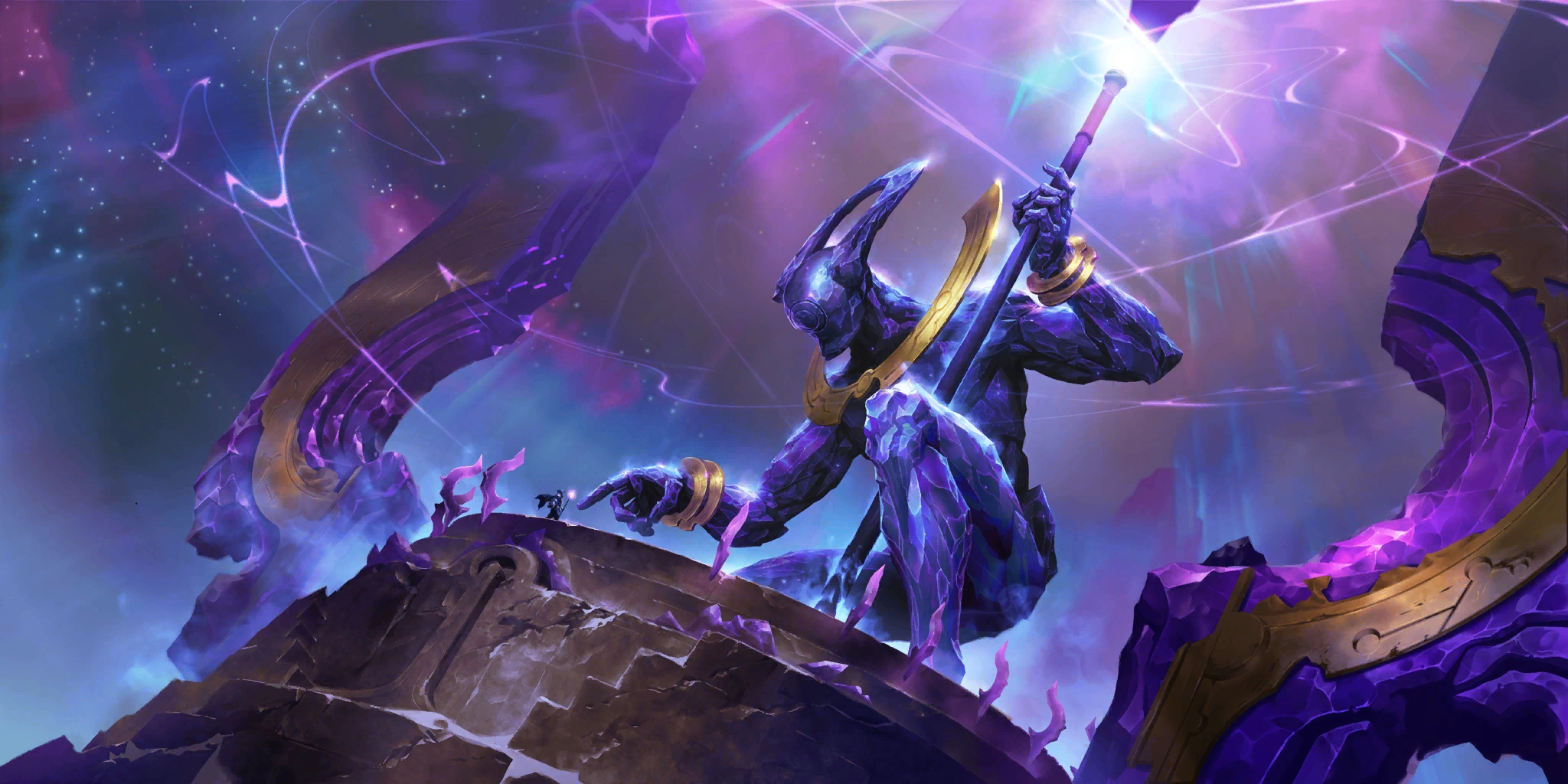Hey there! 4LW here, a long term player, seasonal champion, deckbuilder and 2023’s World Championship top 12 finisher. Being done with my Worlds run, I’m now to discuss the good, the bad and the ugly of LoR in 2023.
I’ll do so mainly from the standpoint of a competitive player, the one from which I am empowered. For that reason, don’t expect me to be digging here on LoR’s partnership with content creators, LoR’s advertisement on other Riot media, and the like, because I can’t really discuss those properly. Expect discussions about the new competitive structure, balancing, rotation, money prizes, and everything else surrounding competition within the game.
Competitive 2.0
By the end of January, we got an article by RubinZoo and Zeronena sketching the plans for competitive LoR in 2023. We got introduced to Daily Rumbles and Runeterra Opens, by then still under testing. We also came to know by that time that 2023’s World Championship would have 64 players directly playing the main event, instead of only 16 players like the first two editions of the event.
The change in the number of Worlds seats followed the complaints from the community that, in the first two editions of Worlds, 64 players from each shard supposedly qualified to Worlds, but then needed to play one more qualifier before reaching the main event. Those players who died in that mentioned middle-of-the-road qualifier would leave with empty hands and no glory at all, while the main event qualified players would get a minimum 6750 USD prize money (if I recall correctly).
To spread things better, the middle qualifier was dissolved and all qualifications would now lead directly to the main event. All 64 main event players would now get some amount of prize money, which is nothing but fair.
The structural change in the competitive path had a great timing, because it softened a hard truth that we came to know in March through the official and final Competitive 2.0 article: LoR would have a smaller budget in 2023 than it had in previous years. Being unable to dominate the digital card game market, and being part of a genre in a downfall, LoR struggled to justify to Riot why it needed a bigger or even the same budget for the year.
Although the smaller budget was harsh, the new competitive structure was well received. We were promised fresh and constant competition through Daily Rumbles and Runeterra Opens. Runeterra Opens accomplished that goal, in my opinion. Opens happen pretty much on a monthly basis and create a great flux of competitive tournaments, something that was not the case with old Seasonal Tournaments, which could have months of interval.
Daily Rumbles, and Gauntlet in general, utterly failed to provide a competitive feel, though. At the end, playing Gauntlet for trophies didn’t turn out to be a competition, but a chore. Getting trophies is easy and abusable. For example, after being absent from the game for months I came back and farmed all trophies of a season track road by simply entering Daily Rumbles and conceding my runs with 0 wins, over and over. Devs did react to this pretty quickly and stopped giving trophies to 0 wins Gauntlet runs, but that single change did not fix what Gauntlet turned out to be. The exception here is Ruthless Rumbles, which indeed feels like good competition, since it is the one Gauntlet mode that has some sort of stakes.
At the World Championship’s desk with Boulevard, RubinZoo showed awareness of those Gauntlet issues. He expressed that the team had a hard time balancing the mode between competitive and casual play. For those reasons, I would personally like to see the Gauntlet-trophy system - as a means to competitive goals - gone for 2024, or else completely revamped again. Maybe stick with Ruthless Rumbles, and that’s about it.
Speaking of competitive modes, let’s talk ladder. In both of the articles linked above, devs stated that ladder was going to be much less important for competitive goals in 2023. The tone of discourse was that ladder would be way less competitive than Gauntlet, for instance. If making this statement true was a goal for devs, they failed it. Doing well on ladder is still very important to succeed in qualifying for Worlds. The points you get from top ranked finishes make all the difference for qualification via yearly or season points. And doing well on ladder is much harder than getting those Gauntlet trophies. Hence ladder is much more competitive than Gauntlet to this day. Ladder being competitive was never a problem for me, though. But the mismatch between devs’ discourse and the competitive reality of the game do bother me some.
After all, the new competitive structure ends up positive. Runeterra Opens were a success and devs managed to make Worlds participation fairer and to make an alright spread of the lower prize money. It’s now way harder to get bigger sums out of LoR competition, though. For 2024 I cannot but wish for a bigger budget again. And get rid of the Gauntlet-trophy system, this did not work at all.
Rotation
By the end of March the team announced that rotation was finally coming to LoR. The premium PvP mode would be split between Eternal - a complete mode without any card restriction - and Standard - a restricted mode with only a portion of cards available. The news was received with mixed feelings by the community. Some, especially those who had LoR as their first card game, did not understand why rotation was happening at all, while others argued that it is a vital part of card game design.
Having some experience with card games, I was expecting rotation to hit LoR at some point or another. For that, rotation by itself did not surprise me much. What surprised me, though, was how it would be done. In card games rotation usually happens by chronologically excluding older sets or expansions from the Standard card pool. In LoR it would be very different. Standard would be, I quote, “a format carefully curated with a select group of cards (...) ensuring that the gameplay remains balanced and exciting”. That meant that the pool of cards that remains or leaves Standard would be decided not by some chronological criteria, but arbitrarily by the decision of developers. On paper, that sounded good. Letting chronology entirely decide which cards go and which stay have the risk of wasting some new and unexplored combinations of mechanics. The upside of LoR’s method, then, was devs organically and carefully thinking of what would be the best possible combinations of cards for Standard, ideally with all things considered. The downside of this - which should be clear at this point - is that, for it to work, this method depends too much on devs making the right calls for rotation, and that, not being too easy, is a big risk. Here one cannot but wonder: is LoR, such a fragile game, in a position to take those big risks on the behalf of the developers?
Looking back at what Standard was throughout the majority of the year, I would say that the first batch of rotation (being the first one of an annual cycle) did not succeed much. Standard was for most of the year, plainly speaking, very boring. The power level of Standard dropped considerably from the old complete format. A lot of regions lost their old power houses and did not get anything in compensation. The meta in some periods of the year resembled some metas from 2020 or 2021.
Devs seemed, in deciding the rotation batch, to take in factor the releases throughout the year. Shadow Isles would get Mordekaiser later on; Targon, in turn, would get Morgana. From that anticipation, it may have seemed reasonable to cut a lot of good cards for those regions, which lost powerful champions like Zoe, Aphelios and Elise. The result of this anticipation, though, was some regions feeling shattered and being competitively weak for a big part of the year on the live build of the game, something that was very unsatisfying.
Moreover, a lot of the rotation decisions looked very questionable. Some recurrent meta breaking cards got to stay in Standard. Good examples here can be Cataclysm, She Who Wanders and Wiggly Burblebish. Those cards have been extensively used in competitive fields for a very long time and often justify build-arounds, even more than the champions that accompany their decks. If I launch a rotation with the premise of making Standard balanced, fresh and inventive, cards like those would be top of my priority list to hit Eternal.



On the other side, cards competitively underexplored, with potential to have much more representation, rotated with little reason. Good examples here can be Arbiter of The Peak and Mind Meld. Although Mind Meld was included as one or two copies in some competitive decks in the past, it never felt as core and important as overused top-end spells like Feel The Rush and Champions’ Strength. Such a card had potential to have a larger space in Standard, but rotation would not allow it.


Mind Meld gone also points out another worth pointing negative part of the first batch of rotation: the lack of big win conditions in Standard. Mind Meld, Glorious Evolution, Atrocity, Decimate… All gone. At some points of the year it felt like devs wanted the game to be mostly played in a Shen/Jarvan or Jax/Ornn midrange style of play. Develop some mid-sized units, win the board, hit the enemy nexus some turns and eventually win from that pattern. Nothing wrong with such a pattern, but a big prevalence of that after years of development can make your game feel rather dull. Happily, some big win conditions remained in Standard: The Harrowing, Battle Fury, Warmother’s Call and some others got to remain and offered at least some windows to avoid the prevalent gameplay.
Some complaints were also made by the community throughout the year that spell-based decks were not getting the proper support. This is partially true, but at least Karma and Seraphine got to stay in Standard and were competitive enough to offer spell fans viable options all year. And the recent Norra/Elder Dragon archetype offered even more alternatives for that type of player. While I think that spell fans are eating good enough, if the second batch of rotation were to take away especially Karma and Seraphine, viable options for a similar gameplay should be given right away.
The major archetype-based flaw of rotation, in my opinion, though, has to do not with top-ends or spell decks, but with burn aggro. 2023 was a rough year to aggro. Decimate, Legion Rearguard, Elise, Doombeast, Get Excited, Ruinous Path were all moved to Eternal. On top of that, Standard now has Cosmic Youngling, a card that can on its own predate any threat of dominant aggro meta. Recent World Champion Talpinator noticed that in his post-tournament interview, saying that when you scroll through your Standard collection you don’t see many competitively viable options for aggressive gameplans. True enough, and the result of this is spectacularly long bo3 matches during official tournaments. Artificially constraining gameplans like aggro did not seem to be the goal of rotation, but, with the lack of viable pieces for reposition, this was the outcome that we’ve got.
I digress a bit on the discussion of archetype-based rotation in the last three paragraphs, and I’m not sure to what extent readers will agree with the points presented. What is even more important to my case here, though, is that Standard has felt much more boring to play than Eternal throughout a good part of the year. The power level drop and the rotation of a lot of beloved and flexible cards like Twisted Fate, Zoe and Elise made Standard feel unsatisfying. Fate’s Voyage, in being an expansion with fun and flexible champions with a very high power level, succeeded in helping to remedy some of the issues of Standard, but it may have come a little too late in the year. For 2024, LoR could use a better distribution of rotation and new content release.
Balance
Live balance has had ups and downs in 2023. It succeeded in helping to create new viable and interesting archetypes out of the the 4.7 buffs to Warden of The Tribes and Glacial Saurian and in 4.10 it impactfully strengthened a numerous amount of cards, like Nine Lives, Wings of The Cryphoenix, Mad Ol’ Babs, Omen Hawk and others. Those were all beneficial to Standard walking towards being a more satisfying format.
But live balance also went wrong. My main prick with it throughout 2023 is the insistence on completing shutting down previously powerful cards. It happened to Samira and Wildfire in 4.10, to Cosmic Call in 4.11, to Swain in 4.8 and to Heisho, Shell of The World in a recent hotfix. Those were all cards enabling whole archetypes. Completely killing those instead of efficiently toning them down to a sweet balanced spot is not it. When you shut down good cards through balance you help restraining even more the availability of competitive cards and decks in Standard, a format that already suffered from those limitations throughout the year.
Moreover, 2023’s live balance wasted many buffs to cards that did not end up being good at all. Children of The Forest and The Zaun Diva on 4.10, The Etherfiend and Dedicant of The Challenge on 4.11, Blink Pack Poacher on 4.8, Baccai Witherclaw on 4.7 and others were all buffs that ended up not mattering at all. Those cards are all very weak, and soft buffs will not help them out too much. The inability from the balance team to assess that some buffs will not be impactful enough combined with the pattern of nerfing cards to the ground leaves me with mixed feelings towards LoR’s live balance job in 2023. For 2024 I wish for even more efficient buffs, like the ones mentioned to Glacial Saurian and Warden of The Tribes, and less inefficient ones. And I wish that the team quits the recurrence of nerfing cards into oblivion.
Worlds 2023
I’ll end this lengthy article with a quick discussion of 2023’s World Championship, the ultimate goal of the competition throughout the year. First of all, the event was very well organized by Riot and Aegis, and it was a blast to participate in it. The new format of swiss on day 1, top 16 on day 2 and finals on day 3 was a nice spread of action to the now 64 player tournament. Swiss leading to double elimination made the results as fair as card games can be, and I would like to see that format again next year.
Although the overall monetary prize was lower than previous years, the additional prize for the finalists of the tournament of getting to make their own cards to the game that they put a lot of effort in was a nice and very clever work around, one to be commended.
The one negative part was the balance hotfix after more than a week of practice for competitors, but this was surpassed by the positive aspect of the event.
And congrats to Talpinator, our new world champion, who showcased some top-notch Legends of Runeterra plays!


